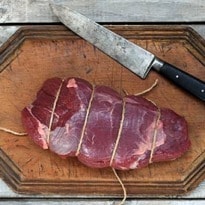Low in fat, high in protein, stacked with vitamins and iron and this year, fed on a summer of bumper pastures.
Wild or farmed, venison is always a first-rate meat choice. Free-range and pasture-fed, it has a slightly finer grain than beef. If you have only ever tasted venison in the customary red wine marinade stew, you might have found it too robust - but don't be put off. A well-butchered cut of fresh venison shouldn't be tough or aggressively gamey; in fact, it's often easy to confuse it with beef. Now is a great time to buy wild venison; the deer are in top form after a summer of abundant feeding. Farmed venison is a less variable, more consistent meat in terms of eating quality, making it a sound year-round choice. Venison is very lean, so either cook it fast and high, or add extra fat (belly pork, bacon, butter, duck fat) to keep it moist.
Why is venison good for me?
It has more protein than any other red meat, which means that it sates the appetite really well. It is also particularly rich in iron (moreso than beef), which prevents anaemia and is good for energy levels. It's full of B vitamins: B2 (riboflavin) and B3 (niacin), which help regulate metabolism; and vitamin B6 and B12, which may lower homocysteine build-up in the blood, thus lowering the risk of heart attacks and strokes. Thanks to all the wild and pasture food that deer eat, the small amount of fat in venison is likely to contain high levels of conjugated linoleic acid, which is thought to protect against heart disease and cancer.
Where to buy and what to pay
Buy wild venison from a traditional butcher/game dealer. Farmed venison is easy to find at farmers' markets, online, and by mail order. Guide price per kilo: £5 (mince), £8-12 (stew), £20 (boned haunch).
Joanna Blythman is the author of What To Eat (Fourth Estate, £9.99). To order a copy for £7.99 with free UK p&p, go to guardianbookshop.co.uk
Chilli and ginger venison in lettuce leaves
This is based on the Thai dish of minced meat cooked with chilli, ginger and garlic then stuffed into crunchy lettuce leaves. It works very well with venison because being lean it can dry out very easily, but this fast cooking method keeps it deliciously moist and tender. The gameyness goes perfectly with these exciting flavours. If lettuce isn't hearty enough, have noodles or rice too.
Serves 4
1 tbsp flavourless oil
600g minced venison
1 tbsp sesame oil
3 cloves garlic, peeled and crushed
4cm ginger, peeled and finely grated
2 red chillies, deseeded and finely chopped
1 small tin water chestnuts, finely chopped
4 spring onions, trimmed, finely sliced
2 tbsp soy sauce
1 tbsp fish sauce
Pinch of brown sugar
1 lime, juiced
1 bunch coriander, finely chopped
Pinch of salt
Leaves of 1 cos or a couple of little gems or an iceberg, washed, dried
1 Heat the flavourless oil in a large frying pan over medium-high heat, add the mince, season with salt, and fry, stirring with a wooden spoon to break up lumps, until it is nicely coloured.Lift the meat out with a slotted spoon and set aside.
2 Add the sesame oil to the pan and the garlic, ginger and chilli, and cook for 2-3 minutes, stirring constantly. Return the meat to the pan and stir thoroughly to get all the ingredients well acquainted. Add the water chestnuts and spring onions, stir well to combine, and heat through.
3 Stir in the fish and soy sauces, a pinch of brown sugar, the lime juice and the coriander, and once the mixture is hot, remove from the heat and place in a serving bowl. Serve with a big pile of lettuce leaves to stuff the mince into.
Rosie Sykes is head chef of Fitzbillies and co-author of The Kitchen Revolution (Ebury Press, £25). To order a copy for £19.99 with free UK p&p, go to guardianbookshop.co.uk
Venison is rich in B vitamins and iron. Photograph: Jill Mead for the Guardian











